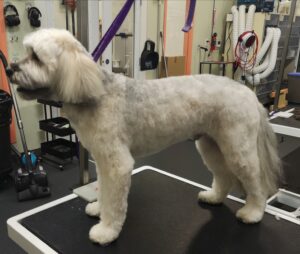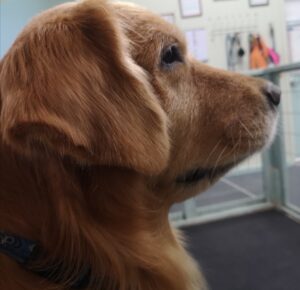Bringing my perspective to problems which all groomers (stylists), including myself struggle with on a regular basis. I’m Jenny. A groomer. This year (2023) I turn 55., and have over 20 years experience as a Professional Pet Stylist. I have been working with dogs since I was 12 years old but explored alternative careers ending with degrees in the sciences and education. I have three degrees, B.Sc., M.Sc., 4 years of an incomplete PhD, and a B.Ed (specializing in children and science). These are just the tip of my educational iceberg. I have held numerous awards in science and graduated with top honors. In 2003 I made a radical change and simply quit my old line of work and took a job as a kennel technician with a local vet. From there the grooming just re-happened. So here I am.
Matted Pet Hair
As a professional pet groomer, I encounter pets that have thick build up of undercoat and/or matting ranging from mild to severe on a daily basis.
Mats that are pulling tightly on the skin to all over tangles. Undercoat build up from an unbreathable layer to tufts popping out of the coat. It all causes or leads to some form of discomfort. When it gets to the point of being a pelt (a carpet) – your pet is suffering.
Air can’t circulate through matted and pelted or overly thick coat/fur/hair, and the skin can’t breath. This means temperature regulation is not possible. Over heating and the chance of moisture remaining near the skin increases and leads to odour, irritations, possible unnoticed parasites and infections.
Chances increase that your pet will get knicks, abrasions and irritation from grooming tools while removing and fixing this problem for you. Grooming tools are sharp, and your pet will be moving more as they are uncomfortable. The photo shows a skip blade. This is a de-matting blade. See the wide teeth separation – this blade can easily cut skin as well as fur. Skin can tent (be pulled along with the fur) and while de-matting can be easily cut.
This is NOT the groomers fault – this is your NEGELCT and groomers are trying their best to fix it for you in the safest way possible. If your pet gets irritated skin, cuts or minor abrasions – IT IS ON YOU! Stop the blame game and accept responsibility. Preventing neglected coat on your pet starts with you. It can be avoided by a regular grooming schedule and diligent at home maintenance. If you can’t maintain a long coat with at home maintenance and professional grooming – then keep a shorter clip that you can maintain within your budget. It will be easier on all – pet, client, groomer.
What causes Mats?
Mats (tangles, knots, burrs, pelts etc. all the same just different words), often occur in areas of friction – under the collar, behind the ears, armpits/chest (harnesses), groin/belly, legs/feet – anywhere on your pet that is in contact with ground/water. Pets that go into the bush collect debris in their coat and not removing the debris leads to a tangle – to a mat – to a pelt. Pets that sit or are petted a lot in certain areas will get mats from the fur being compacted in that spot. An over dry coat that is prone to static will also tangle and mat more.
Neglect, lack of grooming and/or frequent bathing without brushing the coat through also causes matting. It has become harder to maintain pets’ coats as they are indoors, in air conditioning, never mind uncooperative weather. This year the shedding cycle was a whole month out of whack just because warm weather was inconsistent.
Preventing Hair Mats
The best way to deal with mats is to not let your cat or dog get them in the first place!
Regular de-shedding, brushing and combing is the key to maintain a mat-free coat. When brushing, mist the hair with a little moisture (a light leave in conditioner works wonders) to help minimize static and dryness <—– can also cause matting. Use slicker brushes with wire pins and brush in the direction of hair growth.
Ensure your pet’s coat is thoroughly brushed out prior to being bathed or allowed to swim! Often pets with terrible mats are the results of swimming or being bathed frequently at home without proper brushing before and after they have been in the water. Please watch the YouTube video it’s an excellent instruction on line brushing.
When to stop trying to brush it out
The process of removing mats is a hard chore, and your pet can put up with only so much – especially if they are older. When the mats are severe or if the pet cannot tolerate being de-matted for a long period of time, “humanity before vanity”, give your pet a do over – a smoothie – shave it off.
Smoothie grooms are very time consuming as we (the groomer) must use extreme caution while removing the tightly matted coat close to the skin – the skin can “tent” – be pulled up along with the matting and into the blades, which ends in a cut or nick. It is a slow methodical process that takes time to do safely. It is incredibly difficult and delicate work to release matting from the pets body. Plus it is uncomfortable for the pet, and they display unfavourable behaviours as a result. Fighting, biting, gator rolling, bouncing, laying down, flailing to name a few.
Sometimes, as these thick mats are removed, we encounter skin issues (hotspots, maggots, mites), foreign objects, fleas and/or other parasites hiding underneath the mess. Some pets’ skin can become so unhealthy that immediate medical attention may be required.
Hotspots are like third degree burns. They are sore, uncomfortable, get infected and require immediate medical intervention. Once they dry up they become scabby and itchy. Scratching can make them worse.
A matted pet is serious. A matted pet is not a happy pet and ultimately it can be prevented. It starts with you!
After a Smoothie
After a smoothie your pet will feel and act different. Being mat free, your pet will be itchy or his/her skin may be irritated from the matting and close shaving process. Your pet may be inclined to rub and scratch itself, especially on areas that used to be tight. If there was a hotspot rubbing and itching may cause it to worsen, prolong healing and result in coat loss. Be mindful that freshly clipped nails are sharp and can cause cuts and further irritations on already tender skin EVEN WHEN FILED! You may apply a soothing cream or spray; usually a form of hydrocortisone for relief. If it is severe then a vet visit and antibiotics. Anything to do with skin can take weeks to months to resolve. Dog and cat skin are delicate.
Giving your pet a smoothie can be traumatizing for your pet as they no longer have the matted coat protection and can feel very insecure. Your pet may hide, be more shy and submissive, and/or appear uncomfortable. You can help your pet overcome this by putting on some form of clothing around his/her body (e.g., onesie, anxiety wrap, thunder shirt) to help them feel more at ease.
Ongoing Maintenance
Now that your pet has been shaved down, the fur/hair will grow again – just because it is short doesn’t mean it doesn’t need to be maintained. Comb and brush your pet’s hair daily at home and establish a regular schedule for his/her future grooms!
If you own a hair cut breed, they need to be groomed minimum every 8 weeks, unless you choose to maintain a very short length then it may be possible to push appointments to 10 to 12 weeks. I do not recommend this or leaving haircut breeds longer than 12 weeks. A minimum schedule of 8 weeks or less is a better choice.
If you own a natural coated dog (one that requires deshed treatments to remove shedding coat), they need grooming every 6 to 10 weeks, depending on breed. Again, you can push appointments to 12 weeks but that is the maximum length between appointments before the undercoat becomes unmanageable.
From a dermatological grooming perspective monthly grooming for all breeds is the best choice as it fits in with the skin and hair growth cycle. Working together we can ensure that your pet is cared for properly and his/her hair will never get into such poor condition again.



